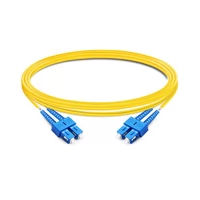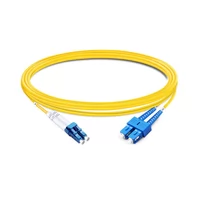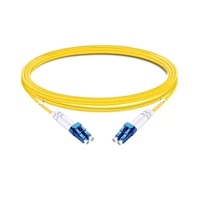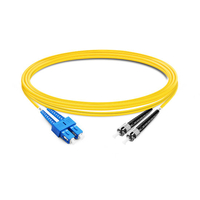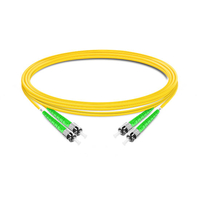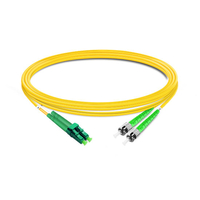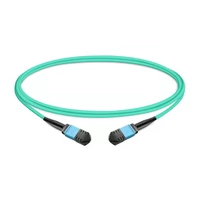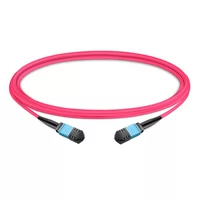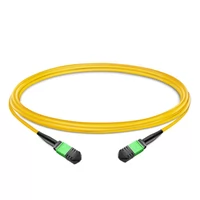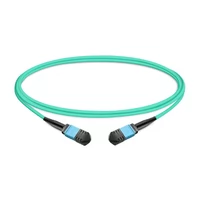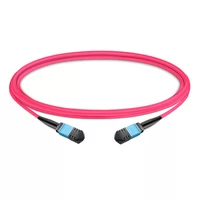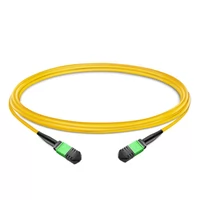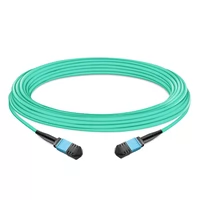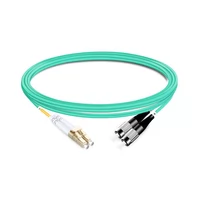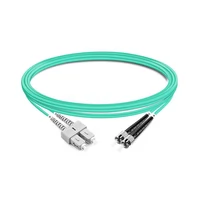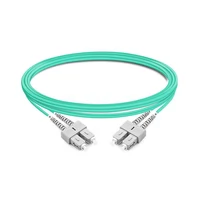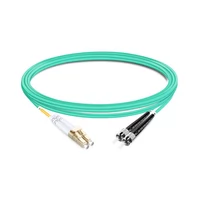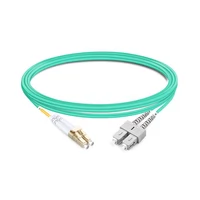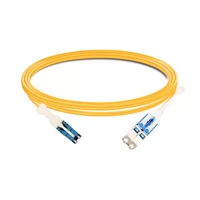What is Fiber Optic Cable
The Major Benefits of Fiber Optic Cable
Easy Handling
Some communication systems require tens or even hundreds of fibers (such as a metro backbone system). Put fibers in a cable make it very easy to install and maintain.
Protection from damaging forces
Fiber optic cables have to be pulled into place through ducts (outdoor) or conduits (indoor). Pulling eyes are attached to the strength members or cable outer jackets. This is critical for isolating the fibers from the applied pulling forces. Glass fibers cannot endure more than 0.1% to 0.2% elongation during installation.
Protection from harsh environment factors
Cable structures protect fibers from moisture (outdoor cables), extreme temperature (aerial cables), and the influx of hydrogen into the fiber (which causes light absorption peak at 1380nm which in turn impair fibers’ transmission properties).
The Difference Between Single-Mode Fiber Optic Cable and Multimode Fiber Optic Cable
The difference in cable transmission distance:
The dispersion between modes of single-mode optical cable is very small, is suitable for remote communication. But there are also material dispersion and waveguide dispersion. Therefore, single-mode optical fiber has high requirements on the spectral width and stability of the light source. That is, the spectral width is narrow and stable. Multimode is used at close range. Since there are hundreds of modes transmitted in multimode fiber optic cable, the propagation constant and a group rate of each mode is different, which makes the fiber narrow in bandwidth, large in dispersion, and large in the loss. It is only suitable for short-distance and small-capacity optical fiber communication systems. Generally, it is more than 100 meters, and the network cable cannot be used.

Cable type:
Multimode fiber optic cable: OM1 OM2 OM3 OM4 OM5.
Single-mode fiber optic cable: OS1 OS2
The essential difference of the optical cable: the core material of the single-mode optical cable and the multi-mode optical cable is the same, both are optical fibers. However, the outer sheath of the single-mode optical fiber and the multi-mode optical fiber is different, and different outer sheaths are suitable for different environments. Single-mode fiber: The center glass core is very thin (the core diameter generally is 9 or 10 μm), and only one mode of fiber can be transmitted. Multimode fiber: A fiber that transmits multiple modes at a given operating wavelength. According to the distribution of its refractive index, it is divided into the mutant type and gradual type.
Common Fiber Optic Connector
Fiber Optic Connector (LC Type)
1、all size for easy installation
2、Multiple fiber options:single mode fiber 9/125 μm
multimode fiber 50/125μm and 62.5/125μm
ribbon fiber 2-12 core
special optical fiber, polarization-maintaining fiber, etc.
3、Multiple cable types: Φ0.9 mm, φ1.6mm or 2.0 mm,
Φ1.6mm or 2.0 mm double core parallel cable
4、End face grinding method: PC grinding
5、Mechanical performance meets IEC 11801 and EIA 568A,
FOCIS10
6、Connection method: plug and pull-type locking structure, can be
used in parallel.



7、Applied ranges:
Optical distribution frame
Various fiber optic devices
Optical transceiver
Equipment with high density and large capacity requirements
The size of the interface:

Fiber Optic Connector / Wire Jumper (SC Type)
1、Comply with NTT standards
2、Multiple fiber options: single-mode fiber 9/125 μm
multimode fiber 50/125μm and 62.5/125μm
ribbon fiber 2-12 core
special optical fiber, polarization-maintaining fiber, etc.
3、Multiple cable types: single core cable φ0.9, φ2, φ2.5, φ3 mm
parallel twin cable 2 xφ2, 2 xφ3 mm
indoor and outdoor bundle fiber optic cable 2-72 core
4、Ferrule end face type: PC grinding
5、Mechanical performance meets IEC 874-7 and CECC 86115-80
6、Small operating space, easy to dense installation
7、Plug and pull structure, easy to operate
8、Mechanical performance meets EN 50173 and EIA-568-A
9、Connection method: Bayonet clamping


10、Applied ranges:
For fiber optic transmission networks;
Optical distribution frame;
Optical transceiver;
Light instrumentation;
Fiber Test System;
SC /APC is mainly used for CATV networks.
The size of the interface:

Fiber Optic Connector / Wire Jumper (FC Type):
1、Comply with NTT standards
2、Multiple fiber options: single-mode fiber 9/125 μm
multimode fiber 50/125μm and 62.5/125μm
ribbon fiber 2-12 core
special optical fiber, polarization-maintaining fiber, etc.
3、Multiple cable types: single core cable φ0.9, φ2, φ2.5, φ3 mm
parallel double-core cable 2 xφ2, 2 xφ3 mm
indoor and outdoor bundle fiber optic cable 2-72 core
4、Ferrule end face type: PC grinding
5、Mechanical performance meets IEC 874-7 and CECC 86115-80
6、Connection method: threaded locking connection, high tensile strength



7、Applied ranges:
For fiber optic transmission networks;
Optical distribution frame;
Optical transceiver;
Light instrumentation;
Fiber Test System;
FC/APC is mainly used for CATV networks.
The size of interface:

Fiber Optic Connector / Wire Jumper (ST Type)
1、Comply with IEC 874-10 and CECC BFOC/2.5
2、Comply with AT&T-ST standards
3、Multiple fiber options: single-mode fiber 9/125 μm
multimode fiber 50/125μm and 62.5/125μm
ribbon fiber 2-12 core
special optical fiber, polarization-maintaining fiber, etc.
4、Multiple cable types: single core cable φ0.9, φ2, φ2.5, φ3 mm
parallel twin cable 2 xφ2, 2 xφ3 mm
indoor and outdoor bundle fiber optic cable 2-72 core
5、Ferrule end face type: PC grinding
6、Connection method: Bayonet locking structure with key for quick installation.


7、Applied ranges:
For fiber optic transmission networks;
Optical distribution frame;
Optical transceiver;
Light instrumentation;
Fiber Test System;
ST /APC is mainly used for CATV networks.
Package size:

MPO and MTP connectors
What is an MPO connector? And its advantages
MPO (Multi-fiber Push On) is one of the MT series connectors. MPO’s compact design makes it has many cores and small size. It is widely used in high-density integrated optical fiber lines in the wiring process, FTTX and 40/100G SFP, SFP+, and other connected applications within transceiver devices.




What is an MTP connector?
The MTP connector is a high-performance MPO connector with multiple innovative designs. The MTP fiber connector is enhanced in optical and mechanical properties compared to conventional MPO connectors.
Table of Contents
ToggleRelated Products:
-
 1m (3ft) Duplex OS2 Single Mode SC UPC to SC UPC OFNP Fiber Optic Cable
$2.50
1m (3ft) Duplex OS2 Single Mode SC UPC to SC UPC OFNP Fiber Optic Cable
$2.50
-
 1m (3ft) Duplex OS2 Single Mode LC UPC to SC UPC OFNP Fiber Optic Cable
$2.50
1m (3ft) Duplex OS2 Single Mode LC UPC to SC UPC OFNP Fiber Optic Cable
$2.50
-
 1m (3ft) Duplex OS2 Single Mode LC UPC to LC UPC OFNP Fiber Optic Cable
$2.50
1m (3ft) Duplex OS2 Single Mode LC UPC to LC UPC OFNP Fiber Optic Cable
$2.50
-
 1m (3ft) Duplex OS2 Single Mode SC UPC to ST UPC PVC (OFNR) Fiber Optic Cable
$2.50
1m (3ft) Duplex OS2 Single Mode SC UPC to ST UPC PVC (OFNR) Fiber Optic Cable
$2.50
-
 1m (3ft) Duplex OS2 Single Mode SC UPC to SC UPC PVC (OFNR) Fiber Optic Cable
$2.50
1m (3ft) Duplex OS2 Single Mode SC UPC to SC UPC PVC (OFNR) Fiber Optic Cable
$2.50
-
 1m (3ft) Duplex OS2 Single Mode ST APC to ST APC PVC (OFNR) Fiber Optic Cable
$3.10
1m (3ft) Duplex OS2 Single Mode ST APC to ST APC PVC (OFNR) Fiber Optic Cable
$3.10
-
 1m (3ft) Duplex OS2 Single Mode LC APC to ST APC PVC (OFNR) Fiber Optic Cable
$3.10
1m (3ft) Duplex OS2 Single Mode LC APC to ST APC PVC (OFNR) Fiber Optic Cable
$3.10
-
 1m (3ft) 12 Fibers Female to Female MPO Trunk Cable Polarity B LSZH OM3 50/125 Multimode Fiber
$20.00
1m (3ft) 12 Fibers Female to Female MPO Trunk Cable Polarity B LSZH OM3 50/125 Multimode Fiber
$20.00
-
 1m (3ft) 12 Fibers Female to Female MPO Trunk Cable Polarity B LSZH Multimode OM4 50/125
$21.00
1m (3ft) 12 Fibers Female to Female MPO Trunk Cable Polarity B LSZH Multimode OM4 50/125
$21.00
-
 1m (3ft) 12 Fibers Female to Female MPO Trunk Cable Polarity B LSZH OS2 9/125 Single Mode
$26.00
1m (3ft) 12 Fibers Female to Female MPO Trunk Cable Polarity B LSZH OS2 9/125 Single Mode
$26.00
-
 1m (3ft) 12 Fibers Low Insertion Loss Female to Female MPO Trunk Cable Polarity B LSZH OM3 50/125 Multimode Fiber
$32.00
1m (3ft) 12 Fibers Low Insertion Loss Female to Female MPO Trunk Cable Polarity B LSZH OM3 50/125 Multimode Fiber
$32.00
-
 1m (3ft) 12 Fibers Low Insertion Loss Female to Female MPO Trunk Cable Polarity B LSZH Multimode OM4 50/125
$33.00
1m (3ft) 12 Fibers Low Insertion Loss Female to Female MPO Trunk Cable Polarity B LSZH Multimode OM4 50/125
$33.00
-
 1m (3ft) 12 Fibers Low Insertion Loss Female to Female MPO Trunk Cable Polarity B LSZH OS2 9/125 Single Mode
$40.00
1m (3ft) 12 Fibers Low Insertion Loss Female to Female MPO Trunk Cable Polarity B LSZH OS2 9/125 Single Mode
$40.00
-
 5m (16ft) 16 Fibers Female to Female MPO Trunk Cable Polarity B LSZH OM4 50/125 Multimode Fiber APC
$89.00
5m (16ft) 16 Fibers Female to Female MPO Trunk Cable Polarity B LSZH OM4 50/125 Multimode Fiber APC
$89.00
-
 1m (3ft) Duplex OM4 Multimode LC UPC to FC UPC PVC (OFNR) Fiber Optic Cable
$2.90
1m (3ft) Duplex OM4 Multimode LC UPC to FC UPC PVC (OFNR) Fiber Optic Cable
$2.90
-
 1m (3ft) Duplex OM4 Multimode SC UPC to ST UPC PVC (OFNR) Fiber Optic Cable
$3.00
1m (3ft) Duplex OM4 Multimode SC UPC to ST UPC PVC (OFNR) Fiber Optic Cable
$3.00
-
 1m (3ft) Duplex OM4 Multimode SC UPC to SC UPC PVC (OFNR) Fiber Optic Cable
$3.00
1m (3ft) Duplex OM4 Multimode SC UPC to SC UPC PVC (OFNR) Fiber Optic Cable
$3.00
-
 1m (3ft) Duplex OM4 Multimode LC UPC to ST UPC PVC (OFNR) Fiber Optic Cable
$3.00
1m (3ft) Duplex OM4 Multimode LC UPC to ST UPC PVC (OFNR) Fiber Optic Cable
$3.00
-
 1m (3ft) Duplex OM4 Multimode LC UPC to SC UPC PVC (OFNR) Fiber Optic Cable
$3.00
1m (3ft) Duplex OM4 Multimode LC UPC to SC UPC PVC (OFNR) Fiber Optic Cable
$3.00
-
 3m (10ft) Duplex OS2 Single Mode CS/UPC to LC/UPC Uniboot LSZH Fiber Optic Cable
$17.00
3m (10ft) Duplex OS2 Single Mode CS/UPC to LC/UPC Uniboot LSZH Fiber Optic Cable
$17.00

